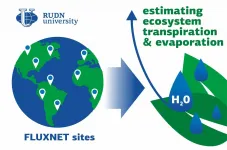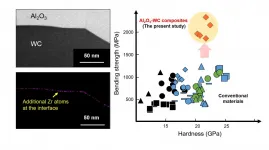Brain 3D genome study uncovers human-specific regulatory changes during development
2021-01-28
(Press-News.org) A team led by Prof. SU Bing from the Kunming Institute of Zoology (KIZ) of the Chinese Academy of Sciences (CAS), Prof. LI Cheng from Peking University, and Prof. ZHANG Shihua from the Academy of Mathematics and Systems Science of CAS has reported the highest resolution by far of the 3D genome of the primate brain, and demonstrated the molecular regulatory mechanisms of human brain evolution through cross-species multi-omics analysis and experimental validation. The study was published in Cell.
The unique pattern of human brain development stems from accumulated genetic changes during human evolution. Among the huge number of diverging genetic changes, only a small portion of the between-species changes have been functionally important. The challenge is to identify the causal changes responsible for the unique pattern of human brain development and their regulatory mechanisms. Macaque monkeys, genetically similar to humans, are the ideal model for studying the origin and developmental mechanisms of the human brain.
The genome of mammalian species including humans is about two meters long and is compiled in the nucleus with a diameter of only 10 micrometers. This nonrandom compilation is characterized by organized three-dimensional (3D) distribution, which is important for cell proliferation and differentiation during development. Recently, the invention of whole-genome chromosomal structure capture technology (referred to as Hi-C) provides a great opportunity for dissecting the fine-tuned organization of the genome during brain development.
In this study, the researchers conducted cross-species analyses of brain 3D genomes through cross-disciplinary collaboration.
They first constructed a high-resolution 3D chromatin structure map of the macaque fetal brain using the Hi-C technique. Reaching a 1.5 kb resolution, this Hi-C map represents the highest resolution of primate brains so far achieved, and it has become a useful omics dataset for revealing the 3D genome organization in detail. Meanwhile, the researchers generated a transcriptome map, a chromatin open region map and a map of the anchor protein CCCTC-binding factor (CTCF).
Based on these multi-omics data, the researchers constructed for the first time a fine map of the chromatin structure of the macaque fetal brain and identified the chromatin structure in different scales, including compartments, topologically associating domains (TADs) and chromatin loops. They also identified regulatory elements in the genome such as enhancers.
Using published human and mouse brain Hi-C data, they then performed a cross-species comparisons, and discovered many human-specific chromatin structural changes, including 499 human-specific TADs and 1266 human-specific loops. Notably, the human-specific loops were shown to be enriched with enhancer-enhancer interactions, representing the origin of a mechanism for fine-tuning brain development during human evolution.
Based on the analysis of single-cell transcriptome data on human brain development, the researchers observed that these human-specific loop-related genes are highly expressed in the subplate lamina, a transient zone of the developing brain critical for neural circuit formation and plasticity. The subplate lamina had been found to show an extradentary expansion compared to that of the macaque and mouse, and is about four times the thickness of the cortical plate. The subplate starts to decrease after birth and eventually disappears, and little is known about this transient zone. This finding provides the first evidence for the key role of the subplate in forming human-specific brain structures during development.
In addition, the researchers discovered that many human-specific mutations (e.g., point mutations and structural changes) are located in the TAD boundary and loop anchor regions, which may lead to the origin of novel binding sites of transcriptional factors and human-specific chromatin structures.
The researchers studied an example involving the EPHA7 gene, which is highly expressed in the subplate and is critical for neuronal dendrite development. The human-specific point mutations of EPHA7 lead to the formation of human-specific enhancers and loops. Through an experiment involving enhancer knockout in cell lines, they proved that human-specific EPHA7 enhancers can cause regulatory changes in EPHA7 expression and affect dendrite development.
This study sheds new light on the genetic mechanisms of human brain origin and serves as a valuable resource for 3D brain genomes.
INFORMATION:
[Attachments] See images for this press release:

ELSE PRESS RELEASES FROM THIS DATE:
2021-01-28
Studying the creation and evolution of sulfur-containing compounds in outer space is essential for understanding interstellar chemistry. CS2 is believed to be the most important molecule in comet nuclei, interstellar dust, or ice cores. CS and S2 are the photodissociation fragments of CS2.
Forty years ago, the emission spectra of only CS and S2 species, and not those of CS2 species, were observed from several comets by the International Ultraviolet Explorer satellite. The photodissociation mechanism of CS2 molecules remains unclear, and S2 fragments have not been experimentally observed before.
Recently, a team led by Prof. YUAN Kaijun from the Dalian Institute of Chemical Physics (DICP) of the Chinese Academy of Sciences (CAS), in cooperation with Prof. WANG Xing'an's group ...
2021-01-28
An ecologist from RUDN University together with colleagues from 14 countries compared three methods for estimating ecosystem transpiration in a study. In the first ever research with such a comprehensive data-set, the team used land-atmosphere water vapor flux data of collected at 251 locations all over the planet, from Australia to Greenland. The outcome of the research help to understand the role of plants in the global water and carbon cycles in the current predicament of global warming. The results of the study were published in the December 2020 issue of the journal Global ...
2021-01-28
Western Carolina University researchers find a disproportionate number of inmates with violent offenses suffer from post-traumatic stress disorder, panic disorder and alcohol use disorder, and published their findings in the Journal of Criminal Psychology.
Alexa Barrett, clinical psychology master's student at WCU, and Al Kopak, associate professor of criminology and criminal justice at WCU, discovered the combination of PTSD, PD and AUD significantly increased the likelihood of violent offenses while conducting research at three county detention centers in North Carolina.
Supported by a Summer Research Assistantship provided by the Graduate School, the purpose of this study was to detail ...
2021-01-28
A PhD student and 'beer scientist' has inadvertently discovered a way to conduct extremely small-scale brewing experiments, potentially leading to better beer.
It came about when University of Queensland PhD candidate Edward Kerr hit a hurdle when he completed a beer brewing experiment for a paper.
"I was looking at barley protein changes during the mashing stage of beer brewing, when one of the paper's reviewers asked if the changes were caused by temperature or time spent mashing the barley," Mr Kerr said.
"It was a good question, but to find out I'd need to brew all over again, with an instrument that would hold at least 23 litres ...
2021-01-28
WASHINGTON, D.C. and SAN DIEGO, CA -- In his inaugural address, President Joe Biden vowed that "help is on the way" to a nation grappling with a pandemic that has already claimed over 420,000 lives and counting. However, despite the promise of a better future, a new survey from West Health and Gallup finds Americans remain largely skeptical that issues as varied as managing the COVID-19 crisis, lowering healthcare costs, improving the economy, fixing immigration and addressing climate change, will improve anytime soon.
The findings from the monthly West Health-Gallup U.S. Healthcare Study are based on a ...
2021-01-28
Pioneering research into how our bodies manufacture the cells that make blood has moved us closer to regrowing tissues and organs. The findings also may let doctors grow the cells for transplantation into people to battle cancer, blood disorders and autoimmune diseases.
Researcher Karen K. Hirschi, PhD, of the Department of Cell Biology and the Robert M. Berne Cardiovascular Research Center at the University of Virginia School of Medicine, has developed a simple and efficient way to generate "hemogenic endothelial cells." These cells are the first step in the production line of blood cells, and Hirschi's new findings provide a blueprint for creating them outside the body.
"By studying how hemogenic endothelial cells develop normally, we gain insights needed ...
2021-01-28
Ceramic matrix composites (CMCs) are incredibly strong materials used in jet engines, gas turbines, and cutting tools for nickel superalloys. Aluminum oxide (Al2O3) is hard and chemically inert, and tungsten carbide (WC) is used as a superhard material, but past efforts to create an Al2O3-WC CMC yielded unsatisfactory results. Recently, a study by Japanese scientists, published in Scientific Reports, shows that adding zirconium atoms results in improved Al2O3-WC CMCs.
Given the potential utility of Al2O3-WC CMCs as superhard materials, researchers around the world have tested several formulations to identify one with a high bending strength, which is a measure of the physical stress a material can be subjected to before it becomes permanently bent or broken. Previously, ...
2021-01-28
In a first-of-its-kind study, researchers discovered that light pollution leads to more than just wasted energy and washed-out starlight--it can increase the likelihood of a preterm birth by almost 13%. Laura Argys, professor of economics at the University of Colorado Denver, collaborated with scientists at Lehigh University and Lafayette College to produce this study.
Skyglow, the brightness of the night sky apart from discrete light sources such as the moon and visible stars, is one of the most pervasive forms of light pollution. When you have increased artificial brightness at night, coming from sources like streetlamps, outdoor advertising, and buildings, it reduces your ability to see the dark ...
2021-01-28
Aging and lifestyle-related metabolic imbalances, such as hyperglycemia, hyperlipidemia, and oxidative-stress, cause the accumulation of advanced glycation end products (AGEs), including pentosidine (PEN, crosslinked type) and carboxymethyl-lysine (CML, non-crosslinked type). Osteoporosis is a widespread metabolic skeletal disease characterized by diminished bone mineral density (BMD) or bone strength, which increases the risk of fractures.
To date, the association of PEN and CML with osteoporotic fracture has been reported, and the accumulation of AGEs in bone ...
2021-01-28
When it comes to drones, the Singapore public is not as keen for them to be used to provide services around their living spaces, finds a study by researchers at the Nanyang Technological University, Singapore (NTU Singapore). However, they are more accepting of drones being used in areas like recreational spots or industrial areas.
There is growing global interest in the use of drones to provide a range of applications - from building inspection to last mile commercial delivery - that promise productivity gains and cost reductions.
In Singapore, the use of drones is picking up, with the government adopting them for various projects in the Smart Nation drive, where technology ...
LAST 30 PRESS RELEASES:
[Press-News.org] Brain 3D genome study uncovers human-specific regulatory changes during development







